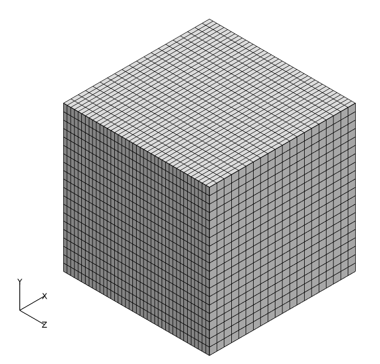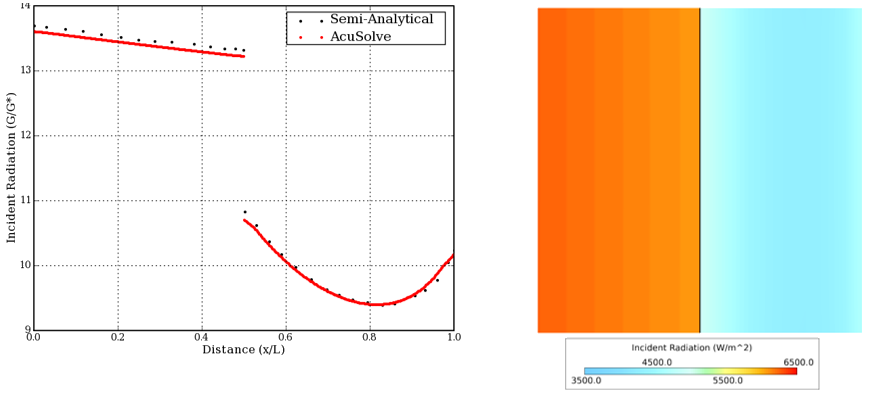Radiation Heat Transfer Through a Cube with a Specular Interface
In this application, AcuSolve is used to simulate the heat transfer due to radiation through a specular interface within an absorbing, emitting, but not scattering solid cube. One of the cube’s walls is modeled with an isotropic external radiation source while the remainder of the cube is held at fixed temperature conditions and modeled with pure radiation, neglecting the effects of conduction.
The internal surface between the two equal solid portions of the cube is specified to be a completely specular boundary condition. AcuSolve results are compared with accepted numerically derived results of incident radiation, as described in Muresan (2004) and Łapka (2012). The close agreement of the AcuSolve results and the published data validates the solver’s ability to model cases with semi-transparent media with differing material properties using the discrete ordinates radiation model.
Problem Description

Figure 1. Critical Dimensions and Parameters Used for Simulating Radiation Heat Transfer Through a Cube with a Specular Interface

Figure 2. Mesh Used for Simulating Radiation Heat Transfer Through a Cube with a Specular Interface
The simulation was performed as a three-dimensional problem by constructing a volume mesh that contains all hexahedral elements with 20, 20, 40 cells in the x, y, z directions.
AcuSolve Results

Figure 3. Two-Dimensional Plot and Contours of Incident Through a Cube with a Specular Interface
Summary
The AcuSolve solution compares well with numerical results for heat transfer due to radiation within a cube containing a specular interface. In this application, two arbitrary materials are subjected to a constant external radiative heat source and the media are defined to absorb, emit, but not scatter the irradiation. As a result of the prescribed radiative heat flux on the left most wall and the fixed temperature constraint across the entire domain, each media receives a non-trivial, varying amount of incident radiation. The AcuSolve solution for the incident radiation across the interface matches well compared to the numerical solution with only a minor difference at the far-right hand side of the domain. The discrete ordinate model requires a fairly large number of ordinate directions in order to obtain the highest accuracy solution. The published results are produced using the S14 quadrature, which is equivalent to 224 discrete ordinate directions.
Radiation Heat Transfer Through a Cube with a Specular Interface
HyperMesh database file: <your working directory>\cube_specular_radiation\cube_specular_radiation.hm.
Global
- Problem Description
- Analysis type - Steady State
- Turbulence equation - Advective Diffusive
- Radiation equation - Discrete Ordinate
- Radiation Ordinate - S14
- Solver Settings
- Convergence tolerance - 1.0e-3
- Relaxation Factor - 0.3
- Flow - off
- Temperature - off
- Nodal_Initial_Condition
- Temperature
- Type - Constant
- Default Value - 300.0 K
Materials
- Temperature
- Glass_HM
- Density
- Type - Constant
- Density - 2500.0
- Specific Heat
- Type - Constant
- Conductivity - 830
- Conductivity
- Type - Constant
- Conductivity - 1.3
- Radiation Properties
- Allow Participating Media Radiation - On
- Absorption Coefficient - 0.2
- Scattering Coefficient - 0.0
- Phase Coefficient - 0.0
- Refractive Index - 1.5
- Density
- Glass2_HM
- Density
- Type - Constant
- Density - 2500.0
- Specific Heat
- Type - Constant
- Conductivity - 830
- Conductivity
- Type - Constant
- Conductivity - 1.3
- Radiation Properties
- Allow Participating Media Radiation - On
- Absorption Coefficient - 2.0
- Scattering Coefficient - 0.0
- Phase Coefficient - 0.0
- Refractive Index - 1.25
Emissivity Model- BB05
- Emissivity - 0.5
- BB
- Emissivity - 1.0
Volumes- S1
- Type - Solid
- Material model - Glass_HM
- S2
- Type - Solid
- Material model - Glass2_HM
Surfaces- Wall_S1
- Simple Boundary Condition
- Type - Wall
- Temperature BC type - Value
- Temperature - 450.0 K
- Radiation Surface
- Type - radiation interface
- Radiation interface type - external
- External emissivity model - BB
- Diffused fraction - 0.0
- Simple Boundary Condition
- Wall_S2
- Simple Boundary Condition
- Type - Outflow
- Radiation Surface
- Type - Opening
- Opening temperature - 375.0 K
- Emissivity model - BB05
- Diffused fraction - 0.0
- Simple Boundary Condition
- Interface_S1
- Simple Boundary Condition
- Type - Auto Wall
- Radiation Surface
- Type - Radiation interface
- Radiation interface type - internal
- Diffused fraction - 0.0
- Simple Boundary Condition
- Interface_S2
- Simple Boundary Condition
- Type - Auto Wall
- Radiation Surface
- Type - Radiation interface
- Radiation interface type - internal
- Diffused fraction - 0.0
- Simple Boundary Condition
- Slip_1_S1
- Simple Boundary Condition
- Type - Slip
- Simple Boundary Condition
- Slip_2_S1
- Simple Boundary Condition
- Type – Slip
- Simple Boundary Condition
- Slip_3_S1
- Simple Boundary Condition
- Type - Slip
- Simple Boundary Condition
- Slip_4_S1
- Simple Boundary Condition
- Type - Slip
- Simple Boundary Condition
- Slip_1_S2
- Simple Boundary Condition
- Type - Slip
- Simple Boundary Condition
- Slip_2_S2
- Simple Boundary Condition
- Type - Slip
- Simple Boundary Condition
- Slip_3_S2
- Simple Boundary Condition
- Type - Slip
- Simple Boundary Condition
- Slip_4_S2
- Simple Boundary Condition
- Type - Slip
- Simple Boundary Condition
- Density
References
Muresan, Cristian & Vaillon, Rodolphe & Ménézo, Christophe & Morlot, Rodolphe. (2004). Discrete ordinates solution of coupled conductive radiative heat transfer in a two-layer slab with Fresnel interfaces subject to diffuse and obliquely collimated irradiation. Journal of Quantitative Spectroscopy and Radiative Transfer. 84. 551-562. 10.1016/S0022-4073(03)00271-1.
Łapka, Piotr & Furmański, Piotr. (2012). Fixed Cartesian grid based numerical model for solidification process of semi-transparent materials II: Reflection and refraction or transmission of the thermal radiation at the solid–liquid interface. International Journal of Heat and Mass Transfer. 55. 4953–4964. 10.1016/j.ijheatmasstransfer.2012.03.077.